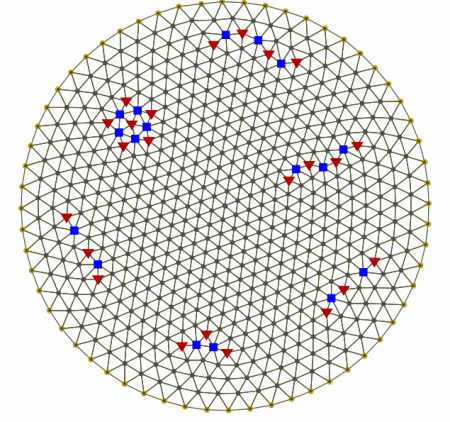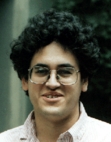John C. Baez's Blog, page 62
December 15, 2017
The 600-Cell
I can’t stop thinking about the 600-cell:

It’s a ‘Platonic solid in 4 dimensions’ with 600 tetrahedral faces and 120 vertices. One reason I like it is that you can think of these vertices as forming a group: a double cover of the rotational symmetry group of the icosahedron. Another reason is that it’s a halfway house between the icosahedron and the  lattice. I explained all this in my last post here:
lattice. I explained all this in my last post here:
I wrote that post as a spinoff of an article I was writing fo...
December 10, 2017
From the Icosahedron to E8
Here’s a draft of a little thing I’m writing for the Newsletter of the London Mathematical Society. The regular icosahedron is connected to many ‘exceptional objects’ in mathematics, and here I describe two ways of using it to construct  One uses a subring of the quaternions called the ‘icosians’, while the other uses Patrick du Val’s work on the resolution of Kleinian singularities. I leave it as a challenge to find the connection between these two constructions!
One uses a subring of the quaternions called the ‘icosians’, while the other uses Patrick du Val’s work on the resolution of Kleinian singularities. I leave it as a challenge to find the connection between these two constructions!
December 9, 2017
Excitonium
In certain crystals you can knock an electron out of its favorite place and leave a hole: a place with a missing electron. Sometimes these holes can move around like particles. And naturally these holes attract electrons, since they are places an electron would want to be.
Since an electron and a hole attract each other, they can orbit each other. An orbiting electron-hole pair is a bit like a hydrogen atom, where an electron orbits a proton. All of this is quantum-mechanical, of course, so...
December 7, 2017
Wigner Crystals
I’d like to explain a conjecture about Wigner crystals, which we came up with in a discussion on Google+. It’s a purely mathematical conjecture that’s pretty simple to state, motivated by the picture above. But let me start at the beginning.
Electrons repel each other, so they don’t usually form crystals. But if you trap a bunch of electrons in a small space, and cool them down a lot, they will try to get as far away from each other as possible—and they can do this by forming a crystal!
This...
November 26, 2017
A Universal Snake-like Continuum
It sounds like jargon from a bad episode of Star Trek. But it’s a real thing. It’s a monstrous object that lives in the plane, but is impossible to draw.
Do you want to see how snake-like it is? Okay, but beware… this video clip is a warning:
This snake-like monster is also called the ‘pseudo-arc’. It’s the limit of a sequence of curves that get more and more wiggly. Here are the 5th and 6th curves in the sequence:
Here are the 8th and 10th:
But what happens if you try to draw the ps...
November 22, 2017
The Golden Ratio and the Entropy of Braids
Here’s a cute connection between topological entropy, braids, and the golden ratio. I learned about it in this paper:
• Jean-Luc Thiffeault and Matthew D. Finn, Topology, braids, and mixing in fluids.
Topological entropyI’ve talked a lot about entropy on this blog, but not much about topological entropy. This is a way to define the entropy of a continuous map  from a compact topological space
from a compact topological space  to itself. The idea is that a map that mixes things up a lot should have a lot of entropy. In parti...
to itself. The idea is that a map that mixes things up a lot should have a lot of entropy. In parti...
November 12, 2017
Applied Category Theory at UCR (Part 3)
We had a special session on applied category theory here at UCR:
• Applied category theory, Fall Western Sectional Meeting of the AMS, 4-5 November 2017, U.C. Riverside.
A bunch of people stayed for a few days afterwards, and we had a lot of great discussions. I wish I could explain everything that happened, but I’m too busy right now. Luckily, even if you couldn’t come here, you can now see slides of almost all the talks… and videos of many!
Click on talk titles to see abstracts. For multi-a...
November 9, 2017
Biology as Information Dynamics (Part 3)
On Monday I’m giving this talk at Caltech:
• Biology as information dynamics, November 13, 2017, 4:00–5:00 pm, General Biology Seminar, Kerckhoff 119, Caltech.
If you’re around, please check it out! I’ll be around all day talking to people, including Erik Winfree, my graduate student host Fangzhou Xiao, and other grad students.
If you can’t make it, you can watch this video! It’s a neat subject, and I want to do more on it:
Abstract. If biology is the study of self-replicating entities, a...
October 31, 2017
Complex Adaptive Systems (Part 6)
I’ve been slacking off on writing this series of posts… but for a good reason: I’ve been busy writing a paper on the same topic! In the process I caught a couple of mistakes in what I’ve said so far. But more importantly, there’s a version out now, that you can read:
• John Baez, John Foley, Blake Pollard and Joseph Moeller, Network models.
There will be two talks about this at the AMS special session on Applied Category Theory this weekend at U. C. Riverside: one by John Foley of Metron Inc....
Complex Adaptive Systems (Part 7)
I’ve been slacking off on writing this series of posts… but for a good reason: I’ve been busy writing a paper on the same topic! In the process I caught a couple of mistakes in what I’ve said so far. But more importantly, there’s a version out now, that you can read:
• John Baez, John Foley, Blake Pollard and Joseph Moeller, Network models.
There will be two talks about this at the AMS special session on Applied Category Theory this weekend at U. C. Riverside: one by John Foley of Metron Inc....
John C. Baez's Blog
- John C. Baez's profile
- 29 followers






